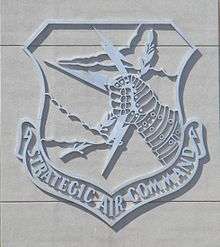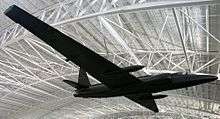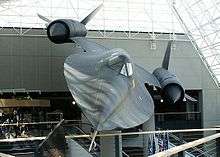Strategic Air Command & Aerospace Museum
|
SR-71A Blackbird on display | |
| Established | 1959, 1998 |
|---|---|
| Location |
Ashland, Nebraska (1998– ) Offutt AFB (1959–1998) |
| Coordinates | 41°01′05″N 96°19′12″W / 41.018°N 96.320°W |
| Type | Aviation museum |
| Director | Michael McGinnis [1] |
| Website | sacmuseum.org |

The Strategic Air Command & Aerospace Museum is a museum focusing on aircraft and nuclear missiles of the United States Air Force. It is located near Ashland, Nebraska, along Interstate 80 southwest of Omaha. The objective of the museum is to preserve and display historic aircraft, missile, and space vehicles and provide educational resources. It is regarded as having one of the top collections of strategic aircraft.[2]
History
Offutt Air Force Base in eastern Nebraska became the headquarters of the Strategic Air Command in 1948, and continues as the headquarters of U.S. Strategic Command. The museum at Offutt, adjacent to Bellevue, a suburb south of Omaha, began with its first airplane in 1959 as the Strategic Aerospace Museum. General Curtis LeMay's vision of a museum that preserved historic aircraft had become a reality. Over the following years, the outdoor museum's name changed to the Strategic Air Command Museum or SAC Museum.
On May 16, 1998, after a $33 million grass roots capital campaign, the museum moved indoors to a location more accessible to the public, between Omaha and Lincoln, that allowed the aircraft to be protected from the elements to which they had previously been exposed. As part of the moving process, two aircraft (a Douglas C-124 Globemaster II and C-133 Cargomaster) were relocated to the Air Mobility Command Museum at Dover Air Force Base, Delaware.
On June 15, 2001, the name of the Strategic Air Command (SAC) Museum was officially changed to the Strategic Air & Space Museum. This change incorporated the museum's rich past while attempting to reach a larger audience through dynamic programming and exciting educational programs that seek to captivate the interests and imaginations of everyone. On June 25, 2015, the museum announced another name change to the Strategic Air Command & Aerospace Museum, in an effort to reconnect to the museum's original mission of preserving the history of the Strategic Air Command while promoting interest in aviation and science among the general public.[3]
The Museum is a $29.5 million, 300,000-square-foot (28,000 m2) building that features a glass atrium, two aircraft display hangars, a traveling exhibit area, a children's interactive gallery, a 200-seat theater, a museum store, an aircraft restoration gallery, and a snack bar. The glass atrium is constructed of 525 glass panels that encase a Lockheed SR-71 Blackbird. The two aircraft display hangars protect the aircraft collection and exhibits from harsh outdoor elements. The museum participates in an exhibit exchange program with other national museums and displays them in the traveling exhibit area.[2] Three large missiles are displayed vertically outdoors in front of the museum.
Collection

on exterior of museum

The museum's collection includes examples of most aircraft operated by the Strategic Air Command, and includes:[2]
- Avro Vulcan B.Mk.II (serial no. XM573), one of three on display in the United States
- Boeing B-17G Flying Fortress (serial no. 44-83559)
- Boeing B-29 Superfortress (serial no. 44-84076)
- Boeing B-47E Stratojet (serial no. 52-1412)
- Boeing B-52 Stratofortress (serial no. 52-8711), the first operational aircraft of its type delivered to the Air Force in 1955.
- Boeing KC-97G Stratofreighter (serial no. 53-0198)
- Boeing EC-135 Looking Glass (serial no. 63-8049)
- Convair B-36J Peacemaker (serial no. 52-2217), one of only four surviving
- Convair B-58A Hustler (serial no. 61-2059)
- Convair F-102A Delta Dagger (serial no. 54-1405)
- Convair T-29A Flying Classroom (serial no. 50-0190)
- Douglas A-26B Invader (serial no.44-34665)
- Douglas C-47A Skytrain (serial no. 43-48098)
- Douglas C-54D Skymaster (serial no. 42-72724)
- Fairchild C-119G Flying Boxcar (serial no. 51-8024L)
- Grumman HU-16B Albatross (serial no. 51-0006)
- Lockheed T-33A T-Bird (serial no. 58-0548)
- Lockheed U-2C Dragon Lady (serial no. 56-6701)
- Lockheed SR-71A Blackbird (serial no. 61-7964)
- Martin B-57E Canberra (serial no. 55-4244]]
- McDonnell XF-85 Goblin (serial no. 46-0524), one of only two ever produced
- McDonnell F-101B Voodoo (serial no. 59-0462)
- McDonnell RF-4C Phantom II (serial no. 65-0903)
- North American B-25 Mitchell (serial no. 44-28738), as well as a partial fuselage of another aircraft.
- North American RB-45C Tornado (serial no. 48-0017)
- North American F-86H Sabre (serial no. 53-1375)
- General Dynamics FB-111A Aardvark (serial no. 68-0267)
- Republic F-84F Thunderstreak (serial no. 51-1714)
- Republic F-105D Thunderchief (serial no. 61-0069), mounted on a pedestal several miles northeast of the museum along Interstate 80.
- Apollo Block I Command Module, flown on AS-201
- Rockwell B-1A Lancer (serial no. 76-0174), one of only two surviving
Several rockets and missiles are displayed outdoors in front of the museum:[4]
- Boeing AGM-86B Air Launched Cruise Missile
- Chance Vought SLV-1 Blue Scout
- Convair SM-65D Atlas
- Douglas PGM-17 Thor
- McDonnell GAM-72 Quail
- Northrop SM-62 Snark
- North American GAM-77 Hound Dog
References
- ↑ "About us: Scott Tarry". NASA Nebraska Space Grant. Retrieved June 19, 2013.
- 1 2 3 Strategic Air Command & Aerospace Museum official website
- ↑ http://sacmuseum.org/2016/03/a-new-name-for-the-strategic-air-space-museum/
- ↑ http://sacmuseum.org/what-to-see/aircraft/missiles-rockets/
External links
| Wikimedia Commons has media related to Strategic Air and Space Museum. |
Coordinates: 41°01′05″N 96°19′12″W / 41.018°N 96.320°W
